Investment Review & Outlook – October 2020
Summary
- The stock market’s meteoric rise, as represented by the S&P 500 Index, from its pre-Covid high in mid-February through the low in mid-March to its new high in August, took only 126 days and was unprecedented in its speed and magnitude.
- We are in the midst of what appears will be a “square root” recovery—an economic bounce back from the initial lockdown followed by a prolonged plateau period in economic growth due to high unemployment and relatively low demand.
- Additional government stimulus will be needed to facilitate economic recovery, shoring up consumers, businesses, and state and local governments.
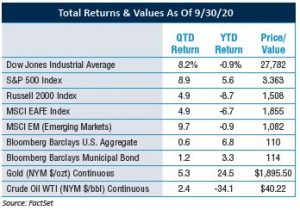 Key Takeaways
Key Takeaways
- We expect that the uncertainty surrounding both the upcoming election and the impact of the ongoing pandemic will result in elevated levels of volatility in the equity markets with the potential for sharp corrections, which may buffet investor confidence.
- Higher current equity valuations and a lower-for-longer interest rate environment set the stage for muted equity and fixed income returns.
- Once a viable vaccine is made available and is widely accepted and administered across the country, we expect a strong economic recovery to take hold.
The Economy & Markets
The Unprecedented Speed of the Market Rebound
As shown in the chart below, the magnitude and speed of the stock market’s recovery since its initial downturn was unprecedented and mirrored the sharp and quick decline from the February high to the March low.
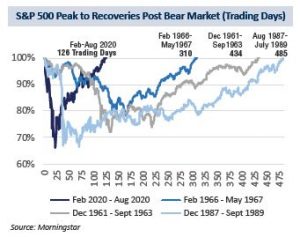
Several factors fueled this accelerated rebound:
- Fiscal and monetary stimulus from the Federal Reserve and Congress – The significant depth and breadth of stimulus actions—the Fed’s interest rate policy coupled with the CARES ACT stimulus checks for individuals and Payment Protection Program loans for small businesses—buoyed investor confidence and provided support to the equity market.
- The TINA (There Is No Alternative) effect – Lower interest rates since the onset of the pandemic drove investors to stocks. While fixed income remains a source of stability and serves to reduce overall volatility in a portfolio, it is unlikely to contribute much in the way of real returns (after inflation) for the foreseeable future.
- Expectations for a strong recovery – The pandemic may end up being comparable to a severe natural disaster, after which the pieces will be in place for the beginning of a protracted economic recovery once a vaccine becomes readily available. Near-term estimates for third-quarter GDP growth are for a 25% rebound, settling down to 5% growth in the fourth quarter.
- Technology and related communication services stocks have become a larger part of the S&P 500 – By the end of the third quarter, the technology and communication services sectors accounted for 39% of the S&P 500. Growth for many of these companies was accelerated by the rapid adoption of their cloud-based “work from home” solutions.
- The return of individual investors – There has been a renewed interest by individual investors in stock trading, particularly in certain momentum stocks. For example, investor excitement surrounding certain IPOs of tech companies in 2020 reflects retail enthusiasm in certain areas of the broader equity market. However, we do not see this speculation as the dominant market driver.
The Fed Sticks To Its Lower-For-Longer Stance
With a change in policy to a flexible average inflation target (now the Fed will wait to see evidence that inflation has reached its 2% target, on an average basis over time, before making any adjustments in the Fed Funds rate), the stage has been set for low interest rates for the foreseeable future. This change formalizes measures implemented in the past few quarters reflecting the interest rate policy the Fed began adopting before the pandemic.
While government stimulus has shored up the economy, more fiscal stimulus from Congress is needed to maintain recovery momentum. State and local governments (collectively representing 17% of GDP) would benefit from additional stimulus dollars.
The pandemic’s impact continues to unfold and, to some extent, has not been reflected in the markets. Parts of the economy will remain under pressure (or will face challenges) until a vaccine is readily available and widely used. Uncertainty surrounding the upcoming election outcome, additional stimulus programs, as well as regulatory, trade, and tax environments likely will only compound the issue. Disappointment on the stimulus front may hamper the recovery and lead to higher unemployment, which negatively impacts many sectors of the economy. The housing market is one example, as recent increases in demand subside and unemployed homeowners find they are increasingly unable to make mortgage payments.
Potential Election Outcomes Fuel Uncertainty
The markets generally respond poorly to uncertainty, and the upcoming elections represent a lot of uncertainty. The potential outcomes, based upon party lines, represent starkly different philosophies on many issues. For example, the Energy, Healthcare, and Financial Services sectors may be affected in various ways depending on which party controls the White House and Congress. While the chart below provides useful historical context about election outcomes and market reaction, the current pandemic environment introduces an unknown variable. The data and past election results represented are meant to be informative, but not predictive of upcoming election results or views.
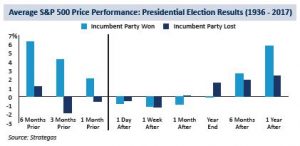
Gold As A Defensive Hedge Garners Investor Interest
One of the beneficiaries of this particular economic environment is gold, up 24.5% year-to-date. In 2020, gold has significantly outperformed many of the major indices including the S&P 500 Index. Reasons for this increased investor appetite include:
- Near zero or negative real interest rates in much of the world
- The significant debt central banks are incurring to support economies, which could fuel some inflationary pressure
- Concern about a weakening US dollar, as a result of stimulus measures, which tends to be negatively correlated to the price of gold
- The role of gold as a defensive hedge in a portfolio of stocks and bonds
American Resilience Prevails
Looking ahead, the US consumer most likely will play a big role in bringing about an economic recovery. At the same time, the entrepreneurial spirit is alive and well in the US, with the capacity to innovate and take risks providing a catalyst for a higher level of economic growth in the future. We anticipate entrepreneurs will start new types of businesses, post-pandemic, which bodes well for our economy.
Equities
Market Leaders
Investment concentration was an overarching theme in the equity market this quarter. Large technology and communication services companies, Apple, Amazon, Microsoft, Alphabet, and Facebook (collectively now representing over 23% of the S&P 500 Index), dominated investor attention and led the equity market recovery. The low interest rate environment spurred investor interest in equities and other risk assets as the TINA effect (There Is No Alternative to stocks) prevailed. Concerns about economic growth drove investors to purchase stocks of companies that demonstrated rising revenue, cash flow, and earnings, including the market-leading companies mentioned above. Valuations for high-growth companies soared as a result. In general, when aggregate equity valuations are high, forward returns are muted.
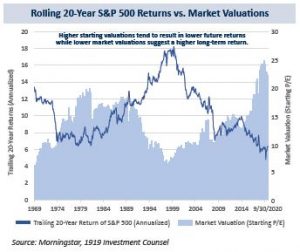
The Early Identification Of Growing Opportunities
At 1919 Investment Counsel, we focus on the opportunities provided by market-leading, large-cap companies, while identifying potential in undervalued sectors that present attractive long-term growth prospects. For example, the Financial Services sector has lagged the market due to lower interest rates and decreasing net interest margins. However, fee income, increased trading activity, the potential release of loan-loss reserves into earnings, and the growth in digital payments mean trading platforms, banks, and fintech companies may offer compelling growth opportunities as the economy recovers.
The Energy sector also is an evolving story with the divergent prospects of fossil fuel companies and renewable energy providers. Our interest in renewables as part of an overall energy strategy includes companies that finance renewable projects and those involved in the generation and storage of renewable energy as well as the development and manufacturing of electric vehicles. These innovative companies offer a compelling and developing long-term growth story.
Once a sustainable recovery is underway, small-capitalization companies should initially lead the charge, as typically happens coming out of a downturn into a new business cycle. An allocation to small-cap stocks as a part of an overall long term equity strategy may make sense for investors seeking to augment long-term growth.
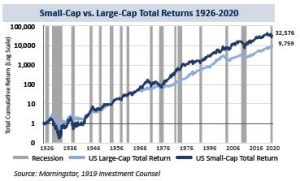
Expect More Volatility
The upcoming election provides a heightened degree of uncertainty for investors, which is magnified by the pandemic. We expect volatility with the potential for corrections as we draw closer to November. However, this is a short-term risk that should be navigated within the context of a long-term investment strategy consistent with the specific goals of each particular portfolio.
Fixed Income
The Search for Yield
In the corporate bond market, the overarching themes are the search for yield and robust demand as investors seek high-quality corporate debt in this low interest rate environment. The following chart tells a stark yield story when inflation is factored in (the real yield is the nominal yield of a bond minus the rate of inflation).
Even with minimal inflation, real yields have turned negative as shown in the 10-Year Treasury real yields chart below.
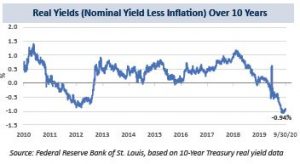
While spreads relative to Treasuries have tightened considerably since March, we expect them to tighten further, albeit modestly, through year-end, supported by strong demand, confidence in the Fed as a safety net, and an improved growth outlook. Given our expectations for prolonged low interest rates, we anticipate low fixed income returns going forward. To generate incrementally higher yields relative to Treasuries in taxable bonds, we favor BBB-rated corporates with intermediate maturities (5-10 years) in fixed income portfolios, as appropriate.
Corporate Bond Issuance
Year-to-date, there has been approximately $1.5 trillion of new corporate bond issuance, well above the $1.15 trillion total for 2019. Many companies issued bonds in March, April, and May to ensure they had enough liquidity to cover expenses through the lockdown. With the economy now opening, a number of companies have chosen to buy back their short-term bonds while issuing longer-term debt. A few companies recently have announced M&A deals, but any debt issuance associated with those acquisitions is unlikely until next year. In addition, the Fed continues to buy Treasuries, although at a slower pace. To the extent there is risk aversion, investors may look to Treasuries for relief.
An Update On Municipal Bonds
In the municipal bond market, we are focused on high-quality essential services and general obligation debt. Additional support for state and local governments would be welcomed to offset the pandemic’s negative financial impact. Whether the next agreed-upon stimulus package will include state and local support is not yet clear. Municipal issuers, such as hospitals, are under revenue pressure due to the pandemic. Moody’s and Standard & Poor’s have a negative rating outlook across most of the muni universe, with the exception of state housing finance agencies and essential service revenue bonds. We favor revenue bonds supporting water, sewer, and electric services.
What We Think
We are living through a challenging time with heightened uncertainty surrounding the pandemic and the upcoming election. The immediacy of the two issues may result in swings in the market as well as investors who become risk-averse. Likewise, higher valuations in the equity market combined with low fixed income yields may result in lower returns across both asset classes. While many investors fixate on short-term risks, which are unpredictable but need to be considered, investment success comes from putting the long term into perspective. In a low interest rate environment, earning income and growing capital will be a challenge. As we have stated many times, high-quality stocks, in many cases with dividend yields that are greater than those of current bond yields, and with the potential for growth of those dividends, offer one of the few avenues for investment returns today.
In closing, it is important to remember that investment risks always exist, both known and unknown. We manage portfolios to navigate any short-term risks, keeping in mind reserves for liquidity needs and cash flow, but remain focused on a long-term investment strategy. This time is no different.
The views expressed are subject to change. Any data cited herein have been obtained from sources believed to be reliable. The accuracy and completeness of data cannot be guaranteed.